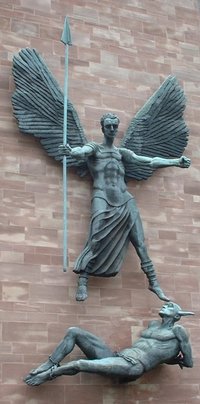Jacob Epstein
|
|
Jepstein.jpg
Sir Jacob Epstein (10 November 1880 - 19 August 1959) was an American-born sculptor who worked chiefly in England, where he pioneered modern sculpture, often producing controversial works that challenged taboos concerning what public artworks appropriately depict.
| Contents |
Life
Epstein's parents were Polish refugees living in New York's Lower East Side. He studied art there as a teenager, sketching the city, and joined The Art Students League of New York in 1900. Then he worked in a bronze foundry by day, studying drawing and sculptural modeling at night. Moving to Europe in 1902, he studied in Paris at the Académie Julian and the École des Beaux-Arts, where Auguste Rodin taught him. He settled in London in 1905, and a few years later became a British Citizen.
Epstein lived in a long-term relationship with Kathleen Garman, whom he married sometime after their daughter's birth in 1926. Their daughter, also named Kathleen, married painter Lucian Freud in 1948 and is mother of two of his daughters.
The Garman Ryan Collection, including several works by Epstein, was donated to the people of Walsall, England, by Lady Kathleen Garman, in 1973, and is on display in Walsall Art Gallery.
JacobEpstein_DayAndNight.jpg
Work
In London, Epstein involved himself with a bohemian and artistic crowd. Revolting against ornate, pretty art, he made bold, often harsh and massive forms of bronze or stone. His sculpture is distinguished by its vigorous rough-hewn realism. Brilliantly avant-garde in concept and style, his works often shocked the general public. He often used expressively distorted figures, drawing more on non-Western art than the classical ideal. People in Liverpool are said to have named his nude male sculpture over the door of the John Lewis department store "Swinging Dick". Such factors may have focused disproportionate attention on certain aspects of Epstein's long and productive career, throughout which he aroused hostility, especially challenging taboos surrounding the depiction of sexuality. Works condemned in his time as obscene and disgraceful today communicate thought and understanding.
London was not ready for Epstein's first major commission — 18 large nude sculptures made in 1907 for the outside walls of Charles Holden's building for the British Medical Association on The Strand (now Zimbabwe House). Considered shocking by Edwardian standards, they were later hacked and mutilated for "decency".
Bronze portrait sculpture formed one of Epstein's staple products, and perhaps the best known. These sculptures were often executed with roughly textured surfaces, expressively manipulating small surface planes and facial details. Some fine examples are in the National Portrait Gallery.
His larger sculpture was his most expressive and experimental, but also his most vulnerable. His depiction of Rima, one of author W. H. Hudson's most famous characters, graces a serene enclosure in Hyde Park. Even here, a visitor became so outraged as to defile it with paint.
Enthusiastic about his work, Epstein would sculpt the images of friends, casual acquaintances, and even people dragged from the street into his studio almost at random. He worked even on his dying day.

Selected Major Pieces
- 1907-8 over-size figures for a façade, The Strand, London - mutilated/destroyed
- 1911 Oscar Wilde Memorial - the Père Lachaise Cemetery, Paris
- 1913-4 "The Rock Drill" (symbolising 'the terrible Frankenstein's monster we have made ourselves into')
- 1917 a marble Venus - Yale Center for British Art, New Haven, Connecticut
- 1919 a bronze Christ - Wheathampstead, England
- 1923 the W. H. Hudson Memorial Rima figure - Hyde Park, London
- 1928-9 Night and Day - 55 Broadway, St. James', London
- 1939 an enormous Adam in alabaster - Blackpool, England
- 1940 "Jacob and the Angel" - the Tate Gallery Collection (originally controversially "anatomical")
- 1947 Lazarus - New College, Oxford
- 1950 Madonna and Child - Convent of the Holy Child Jesus, London
- 1958 "St Michael and the Devil" - Coventry Cathedral
- 1959 Pan - Hyde Park, London
Some Portrait Sculptures
- the Duke of Marlborough
- Joseph Conrad
- Albert Einstein
- George Bernard Shaw
- Oscar Wilde
- Winston Churchill
- Jawaharlal Nehru
Quotation
"A wife, a lover, can perhaps never see what the artist sees. They rarely ever do.
Perhaps a really mediocre artist has more chance of success." -- Jacob Epstein
External links
- Pictures and locations of London artworks (http://www.moodmapper.com)
- Links to Epstein works in pictures (http://www.theo-zimmerman.freeserve.co.uk/epstein.htm)
- Links to works by Epstein (http://www.wingett.com/painters/epstein-jacob-sir.php)de:Jacob Epstein
